light YAMAHA FX SVHO 2021 Owners Manual
[x] Cancel search | Manufacturer: YAMAHA, Model Year: 2021, Model line: FX SVHO, Model: YAMAHA FX SVHO 2021Pages: 116, PDF Size: 5.03 MB
Page 19 of 116
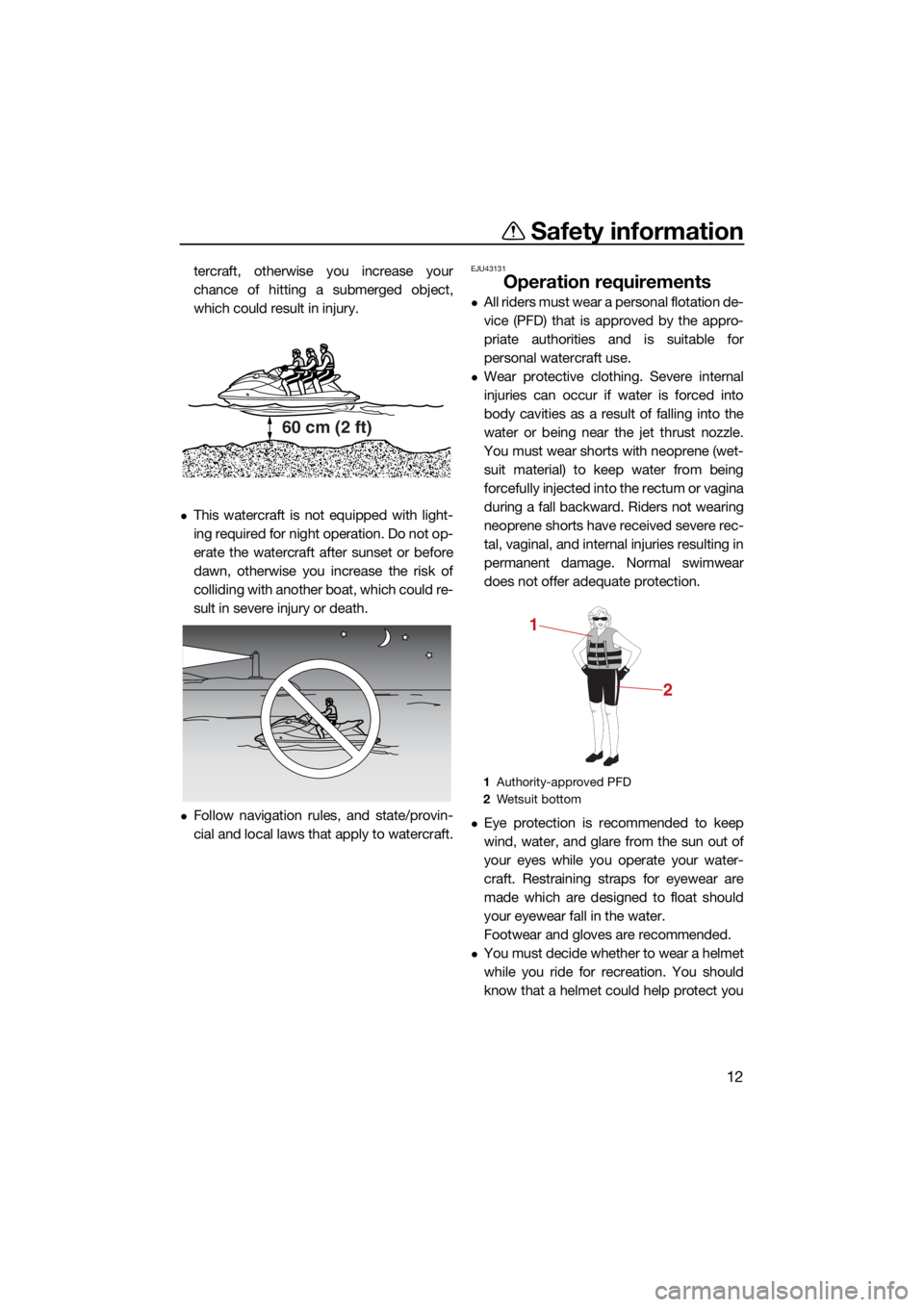
Safety information
12
tercraft, otherwise you increase your
chance of hitting a submerged object,
which could result in injury.
This watercraft is not equipped with light-
ing required for night operation. Do not op-
erate the watercraft after sunset or before
dawn, otherwise you increase the risk of
colliding with another boat, which could re-
sult in severe injury or death.
Follow navigation rules, and state/provin-
cial and local laws that apply to watercraft.
EJU43131
Operation requirements
All riders must wear a personal flotation de-
vice (PFD) that is approved by the appro-
priate authorities and is suitable for
personal watercraft use.
Wear protective clothing. Severe internal
injuries can occur if water is forced into
body cavities as a result of falling into the
water or being near the jet thrust nozzle.
You must wear shorts with neoprene (wet-
suit material) to keep water from being
forcefully injected into the rectum or vagina
during a fall backward. Riders not wearing
neoprene shorts have received severe rec-
tal, vaginal, and internal injuries resulting in
permanent damage. Normal swimwear
does not offer adequate protection.
Eye protection is recommended to keep
wind, water, and glare from the sun out of
your eyes while you operate your water-
craft. Restraining straps for eyewear are
made which are designed to float should
your eyewear fall in the water.
Footwear and gloves are recommended.
You must decide whether to wear a helmet
while you ride for recreation. You should
know that a helmet could help protect you
60 cm (2 ft)
1Authority-approved PFD
2 Wetsuit bottom
1
2
UF3X72E0.book Page 12 Friday, May 29, 2020 10:09 AM
Page 27 of 116

Description
20
EJU43331
Watercraft glossary
Trolling speed
“Trolling” is the lowest maneuvering speed. You are applying little or no throttle. The water-
craft is down in the water, and there is no wake.
Sub-planing speed
“Sub-planing” is a medium speed. The bow of the watercraft is slightly up from the water sur-
face, but you are still traveling through the water. There is a wake.
Planing speed
“Planing” is a faster speed. The watercraft is more level and is skimming on top of the water.
There is a wake.
Bow
The front end of the watercraft.
Stern
The rear end of the watercraft.
Starboard
The right side of the watercraft when facing forward.
Port
The left side of the watercraft when facing forward.
Bilge water
Water that has collected in the engine compartment.
Yamaha Engine Management System (YEMS) YEMS is an integrated, computerized management system that controls and adjusts ignition
timing, fuel injection, engine diagnostics, and the off-throttle steering (OTS) system.
Reverse with Intuitive Deceleration Electronics (RiDE)
RiDE is an electronic system that controls the reverse, neutral, and deceleration operations of
the watercraft.
UF3X72E0.book Page 20 Friday, May 29, 2020 10:09 AM
Page 39 of 116
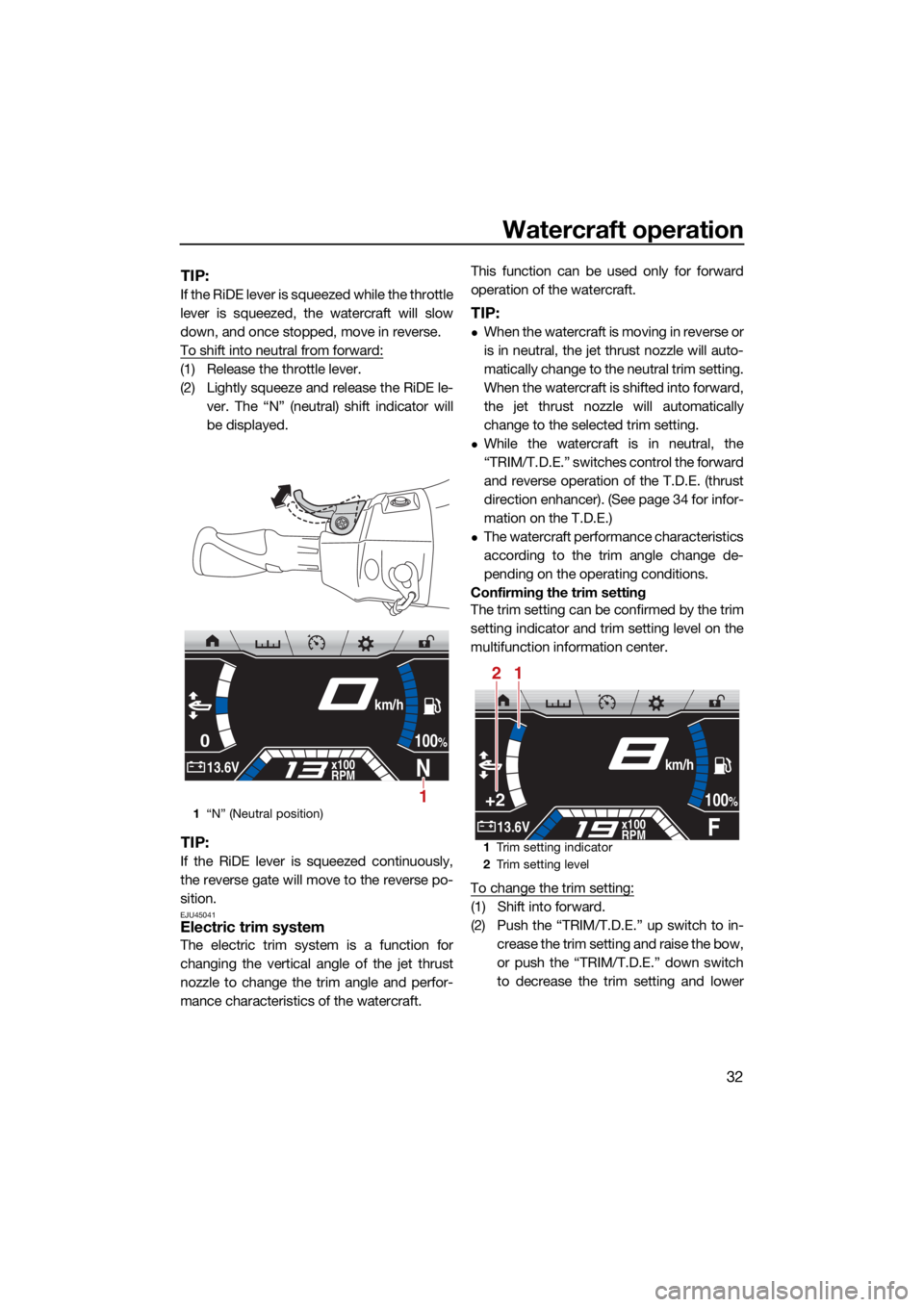
Watercraft operation
32
TIP:
If the RiDE lever is squeezed while the throttle
lever is squeezed, the watercraft will slow
down, and once stopped, move in reverse.
To shift into neutral from forward:
(1) Release the throttle lever.
(2) Lightly squeeze and release the RiDE le-ver. The “N” (neutral) shift indicator will
be displayed.
TIP:
If the RiDE lever is squeezed continuously,
the reverse gate will move to the reverse po-
sition.
EJU45041Electric trim system
The electric trim system is a function for
changing the vertical angle of the jet thrust
nozzle to change the trim angle and perfor-
mance characteristics of the watercraft. This function can be used only for forward
operation of the watercraft.
TIP:
When the watercraft is moving in reverse or
is in neutral, the jet thrust nozzle will auto-
matically change to the neutral trim setting.
When the watercraft is shifted into forward,
the jet thrust nozzle will automatically
change to the selected trim setting.
While the watercraft is in neutral, the
“TRIM/T.D.E.” switches control the forward
and reverse operation of the T.D.E. (thrust
direction enhancer). (See page 34 for infor-
mation on the T.D.E.)
The watercraft perfor
mance characteristics
according to the trim angle change de-
pending on the operating conditions.
Confirming the trim setting
The trim setting can be confirmed by the trim
setting indicator and trim setting level on the
multifunction information center.
To change the trim setting:
(1) Shift into forward.
(2) Push the “TRIM/T.D.E.” up switch to in- crease the trim setting and raise the bow,
or push the “TRIM/T.D.E.” down switch
to decrease the trim setting and lower
1“N” (Neutral position)
0
N13.6Vx100
RPM
100%
km/h
1
1Trim setting indicator
2 Trim setting level
+2
F13.6Vx100
RPM
100%
km/h
12
UF3X72E0.book Page 32 Friday, May 29, 2020 10:09 AM
Page 41 of 116
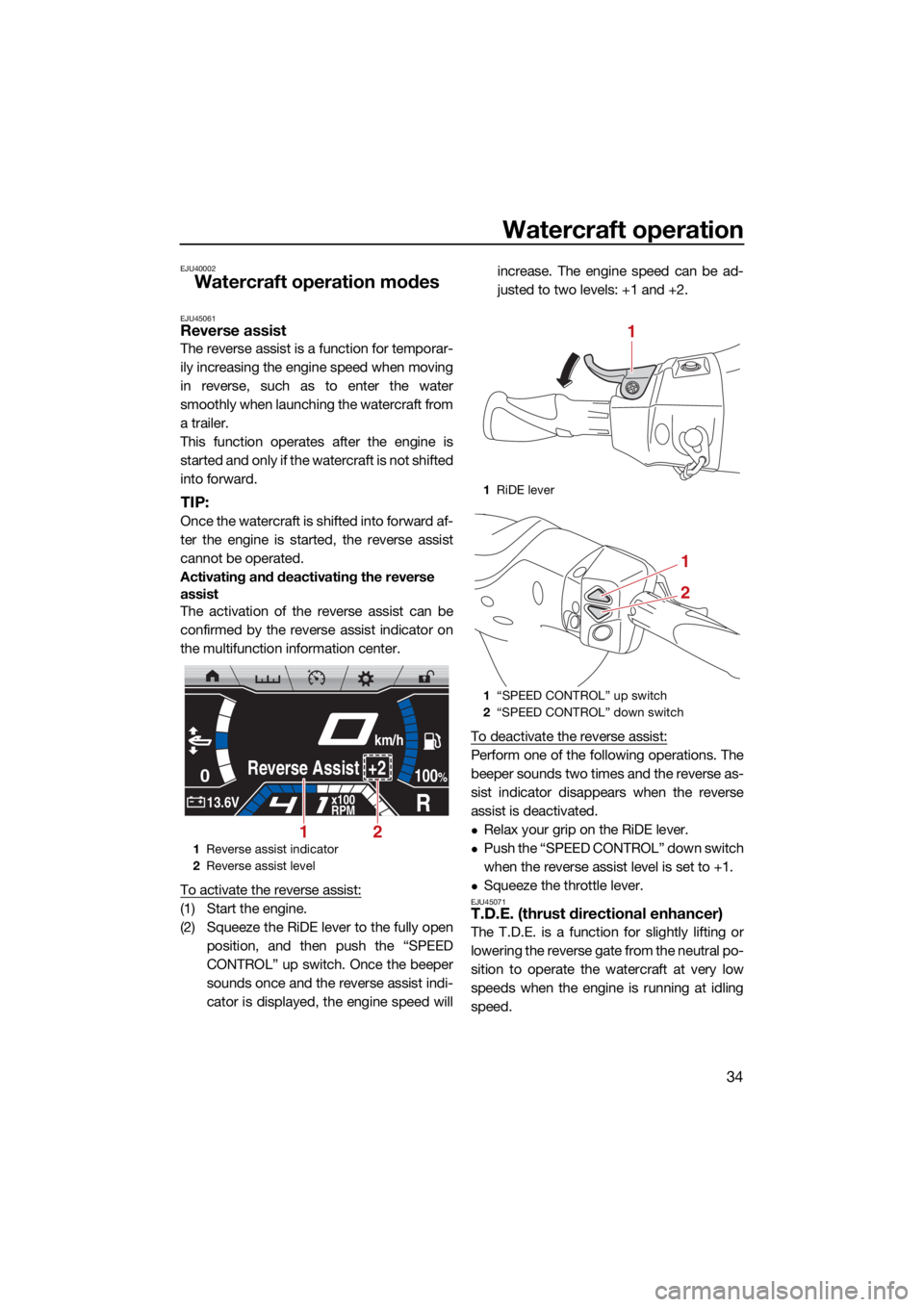
Watercraft operation
34
EJU40002
Watercraft operation modes
EJU45061Reverse assist
The reverse assist is a function for temporar-
ily increasing the engine speed when moving
in reverse, such as to enter the water
smoothly when launching the watercraft from
a trailer.
This function operates after the engine is
started and only if the watercraft is not shifted
into forward.
TIP:
Once the watercraft is shifted into forward af-
ter the engine is started, the reverse assist
cannot be operated.
Activating and deactivating the reverse
assist
The activation of the reverse assist can be
confirmed by the reverse assist indicator on
the multifunction information center.
To activate the reverse assist:
(1) Start the engine.
(2) Squeeze the RiDE lever to the fully openposition, and then push the “SPEED
CONTROL” up switch. Once the beeper
sounds once and the reverse assist indi-
cator is displayed, the engine speed will increase. The engine speed can be ad-
justed to two levels: +1 and +2.
To deactivate the reverse assist:
Perform one of the following operations. The
beeper sounds two times and the reverse as-
sist indicator disappears when the reverse
assist is deactivated.
Relax your grip on the RiDE lever.
Push the “SPEED CONTROL” down switch
when the reverse assist level is set to +1.
Squeeze the throttle lever.EJU45071T.D.E. (thrust directional enhancer)
The T.D.E. is a function for slightly lifting or
lowering the reverse gate from the neutral po-
sition to operate the watercraft at very low
speeds when the engine is running at idling
speed.
1 Reverse assist indicator
2 Reverse assist level
0
R13.6Vx100
RPM
100%Rever se Assist +2
km/h
21
1RiDE lever
1 “SPEED CONTROL” up switch
2 “SPEED CONTROL” down switch
1
1
2
UF3X72E0.book Page 34 Friday, May 29, 2020 10:09 AM
Page 43 of 116
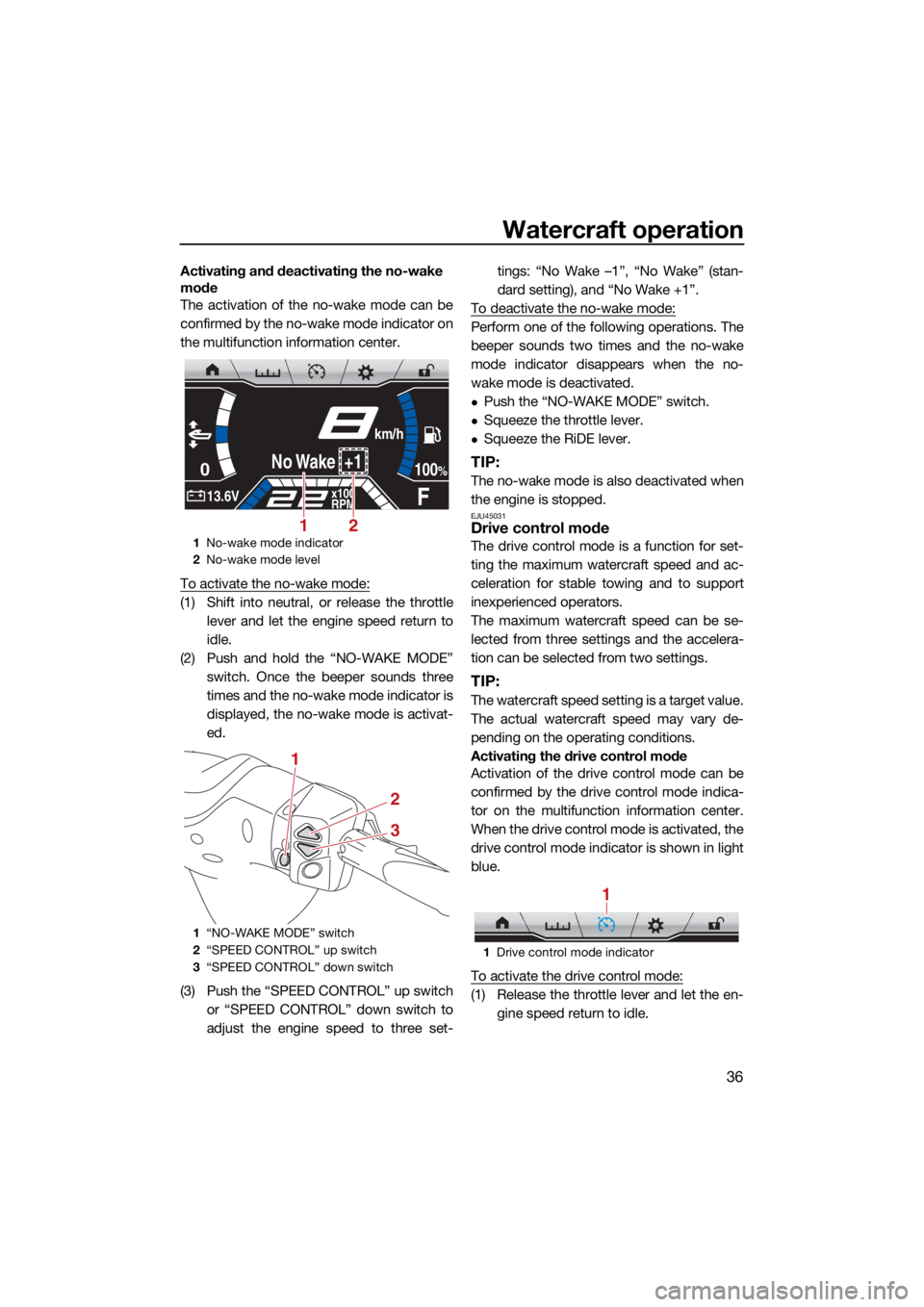
Watercraft operation
36
Activating and deactivating the no-wake
mode
The activation of the no-wake mode can be
confirmed by the no-wake mode indicator on
the multifunction information center.
To activate the no-wake mode:
(1) Shift into neutral, or release the throttlelever and let the engine speed return to
idle.
(2) Push and hold the “NO-WAKE MODE” switch. Once the beeper sounds three
times and the no-wake mode indicator is
displayed, the no-wake mode is activat-
ed.
(3) Push the “SPEED CONTROL” up switch or “SPEED CONTROL” down switch to
adjust the engine speed to three set- tings: “No Wake –1”, “No Wake” (stan-
dard setting), and “No Wake +1”.
To deactivate the no-wake mode:
Perform one of the following operations. The
beeper sounds two times and the no-wake
mode indicator disappears when the no-
wake mode is deactivated.
Push the “NO-WAKE MODE” switch.
Squeeze the throttle lever.
Squeeze the RiDE lever.
TIP:
The no-wake mode is also deactivated when
the engine is stopped.
EJU45031Drive control mode
The drive control mode is a function for set-
ting the maximum watercraft speed and ac-
celeration for stable towing and to support
inexperienced operators.
The maximum watercraft speed can be se-
lected from three settings and the accelera-
tion can be selected from two settings.
TIP:
The watercraft speed setting is a target value.
The actual watercraft speed may vary de-
pending on the operating conditions.
Activating the drive control mode
Activation of the drive control mode can be
confirmed by the drive control mode indica-
tor on the multifunction information center.
When the drive control mode is activated, the
drive control mode indicator is shown in light
blue.
To activate the drive control mode:
(1) Release the throttle lever and let the en- gine speed return to idle.
1No-wake mode indicator
2 No-wake mode level
1 “NO-WAKE MODE” switch
2 “SPEED CONTROL” up switch
3 “SPEED CONTROL” down switch
0
F13.6Vx100
RPM
100%No Wake +1
km/h
21
1
2
3
1Drive control mode indicator
1
UF3X72E0.book Page 36 Friday, May 29, 2020 10:09 AM
Page 44 of 116
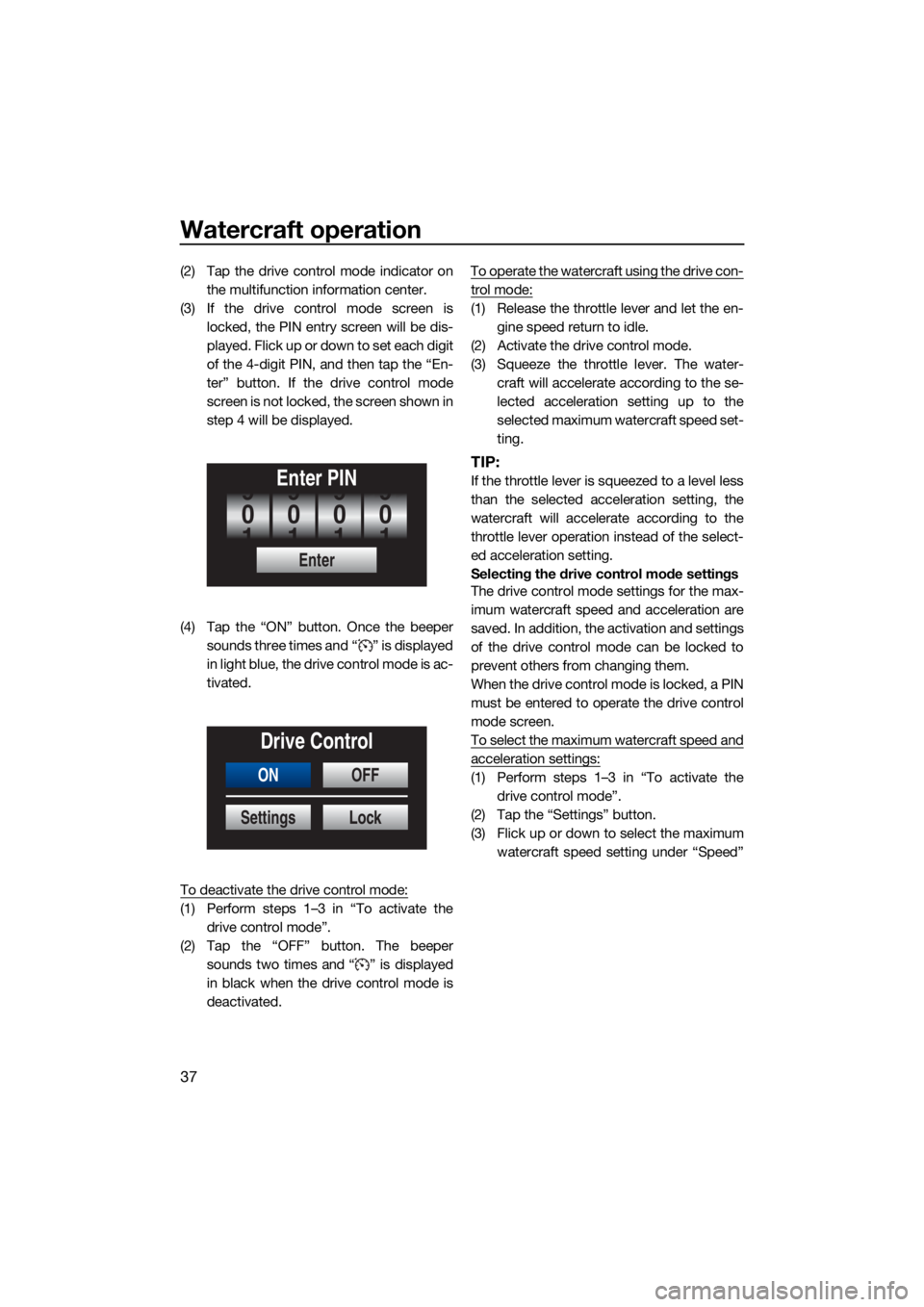
Watercraft operation
37
(2) Tap the drive control mode indicator onthe multifunction information center.
(3) If the drive control mode screen is locked, the PIN entry screen will be dis-
played. F lick up o r down to set each digit
of the 4-digit PIN, and then tap the “En-
ter” button. If the drive control mode
screen is not locked, the screen shown in
step 4 will be displayed.
(4) Tap the “ON” button. Once the beeper sounds three times and “ ” is displayed
in light blue, the drive control mode is ac-
tivated.
To deactivate the drive control mode:
(1) Perform steps 1–3 in “To activate the drive control mode”.
(2) Tap the “OFF” button. The beeper sounds two times and “ ” is displayed
in black when the drive control mode is
deactivated. To operate the watercraft using the drive con-
trol mode:
(1) Release the throttle lever and let the en-
gine speed return to idle.
(2) Activate the drive control mode.
(3) Squeeze the throttle lever. The water- craft will accelerate according to the se-
lected acceleration setting up to the
selected maximum watercraft speed set-
ting.
TIP:
If the throttle lever is squeezed to a level less
than the selected acceleration setting, the
watercraft will accelerate according to the
throttle lever operation instead of the select-
ed acceleration setting.
Selecting the drive control mode settings
The drive control mode settings for the max-
imum watercraft speed and acceleration are
saved. In addition, the activation and settings
of the drive control mode can be locked to
prevent others from changing them.
When the drive control mode is locked, a PIN
must be entered to operate the drive control
mode screen.
To select the maximum watercraft speed and
acceleration settings:
(1) Perform steps 1–3 in “To activate thedrive control mode”.
(2) Tap the “Settings” button.
(3) Flick up or down to select the maximum watercraft speed setting under “Speed”
Enter
Enter PIN
0
9
1
0
9
1
0
9
1
0
9
1
ON
Settings
OFF
Lock
Drive Control
UF3X72E0.book Page 37 Friday, May 29, 2020 10:09 AM
Page 52 of 116
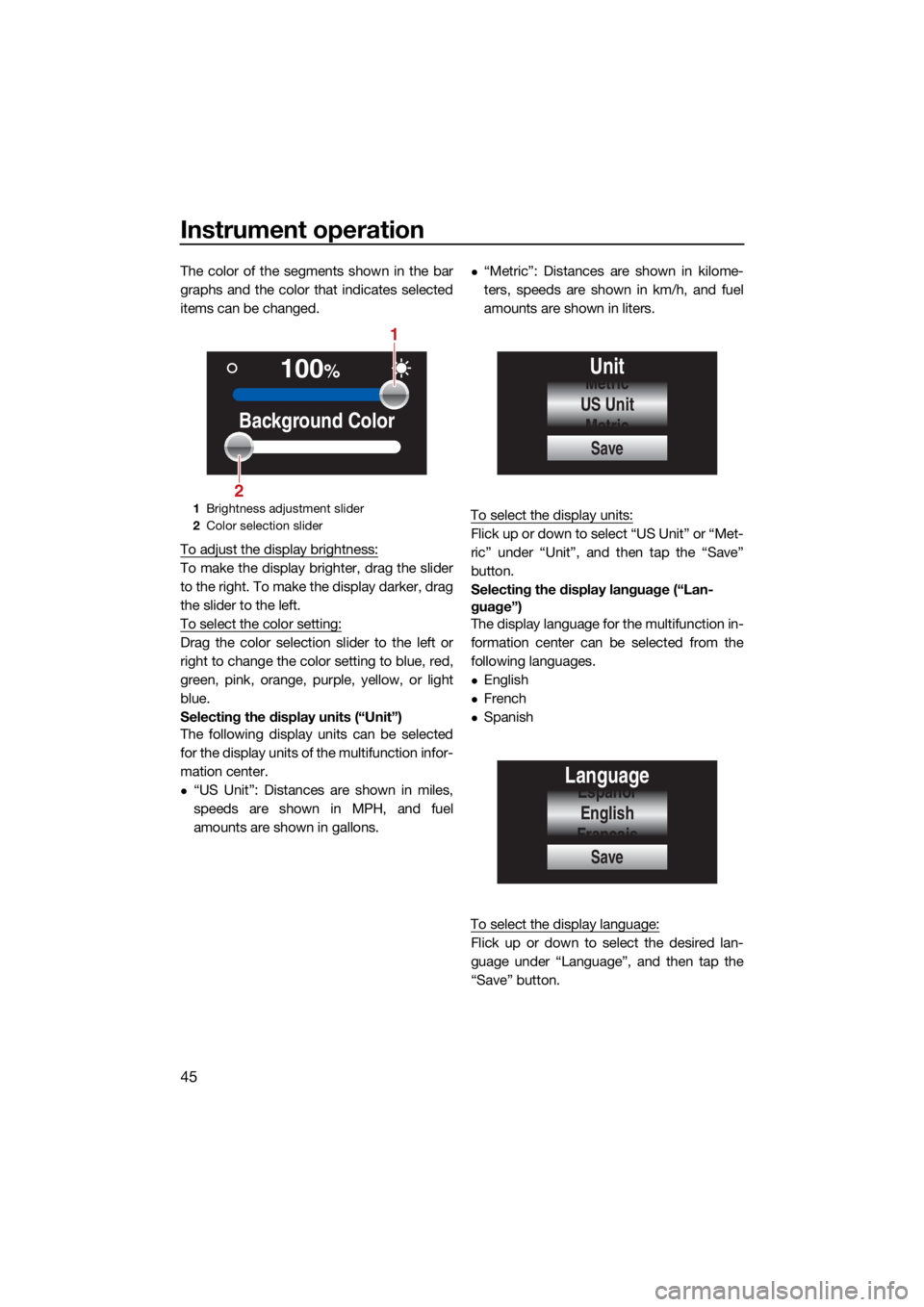
Instrument operation
45
The color of the segments shown in the bar
graphs and the color that indicates selected
items can be changed.
To adjust the display brightness:
To make the display brighter, drag the slider
to the right. To make the display darker, drag
the slider to the left.
To select the color setting:
Drag the color selection slider to the left or
right to change the color setting to blue, red,
green, pink, orange, purple, yellow, or light
blue.
Selecting the display units (“Unit”)
The following display units can be selected
for the display units of the multifunction infor-
mation center.
“US Unit”: Distances are shown in miles,
speeds are shown in MPH, and fuel
amounts are shown in gallons.
“Metric”: Distances are shown in kilome-
ters, speeds are shown in km/h, and fuel
amounts are shown in liters.
To select the display units:
Flick up or down to select “US Unit” or “Met-
ric” under “Unit”, and then tap the “Save”
button.
Selecting the display language (“Lan-
guage”)
The display language for the multifunction in-
formation center can be selected from the
following languages.
English
French
Spanish
To select the display language:
Flick up or down to select the desired lan-
guage under “Language”, and then tap the
“Save” button.
1 Brightness adjustment slider
2 Color selection slider
100%
Background Color
1
2
Save
Unit
US Unit
Metric
Metric
Save
Langua ge
English
Españor
Français
UF3X72E0.book Page 45 Friday, May 29, 2020 10:09 AM
Page 65 of 116
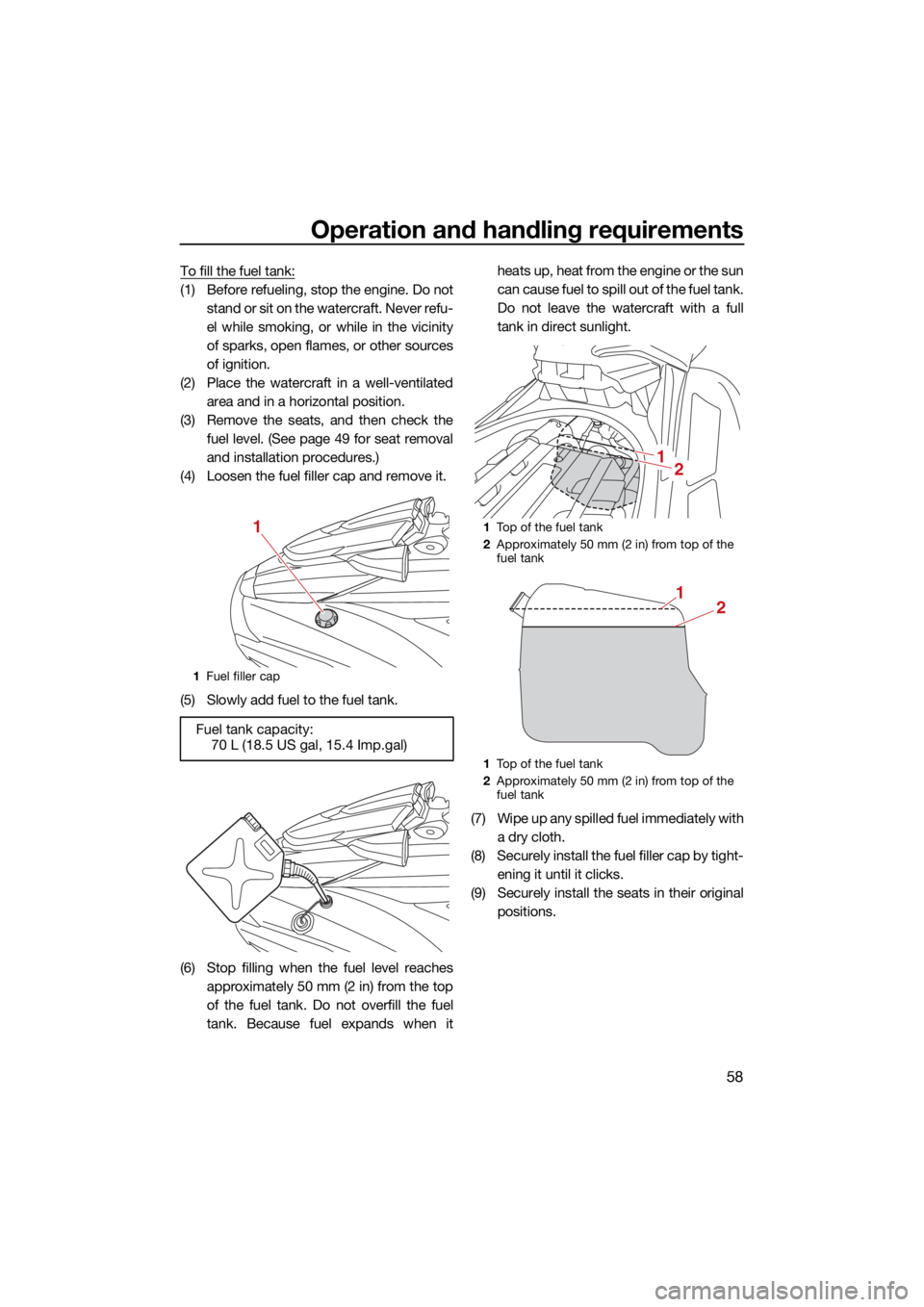
Operation and handling requirements
58
To fill the fuel tank:
(1) Before refueling, stop the engine. Do notstand or sit on the watercraft. Never refu-
el while smoking, or while in the vicinity
of sparks, open flames, or other sources
of ignition.
(2) Place the watercraft in a well-ventilated area and in a horizontal position.
(3) Remove the seats, and then check the fuel level. (See page 49 for seat removal
and installation procedures.)
(4) Loosen the fuel filler cap and remove it.
(5) Slowly add fuel to the fuel tank.
(6) Stop filling when the fuel level reaches approximately 50 mm (2 in) from the top
of the fuel tank. Do not overfill the fuel
tank. Because fuel expands when it heats up, heat from the engine or the sun
can cause fuel to spill out of the fuel tank.
Do not leave the watercraft with a full
tank in direct sunlight.
(7) Wipe up any spilled fuel immediately with a dry cloth.
(8) Securely install the fuel filler cap by tight- ening it until it clicks.
(9) Securely install the seats in their original positions.
1Fuel filler cap
Fuel tank capacity:
70 L (18.5 US gal, 15.4 Imp.gal)
11Top of the fuel tank
2 Approximately 50 mm (2 in) from top of the
fuel tank
1 Top of the fuel tank
2 Approximately 50 mm (2 in) from top of the
fuel tank
21
21
UF3X72E0.book Page 58 Friday, May 29, 2020 10:09 AM
Page 81 of 116
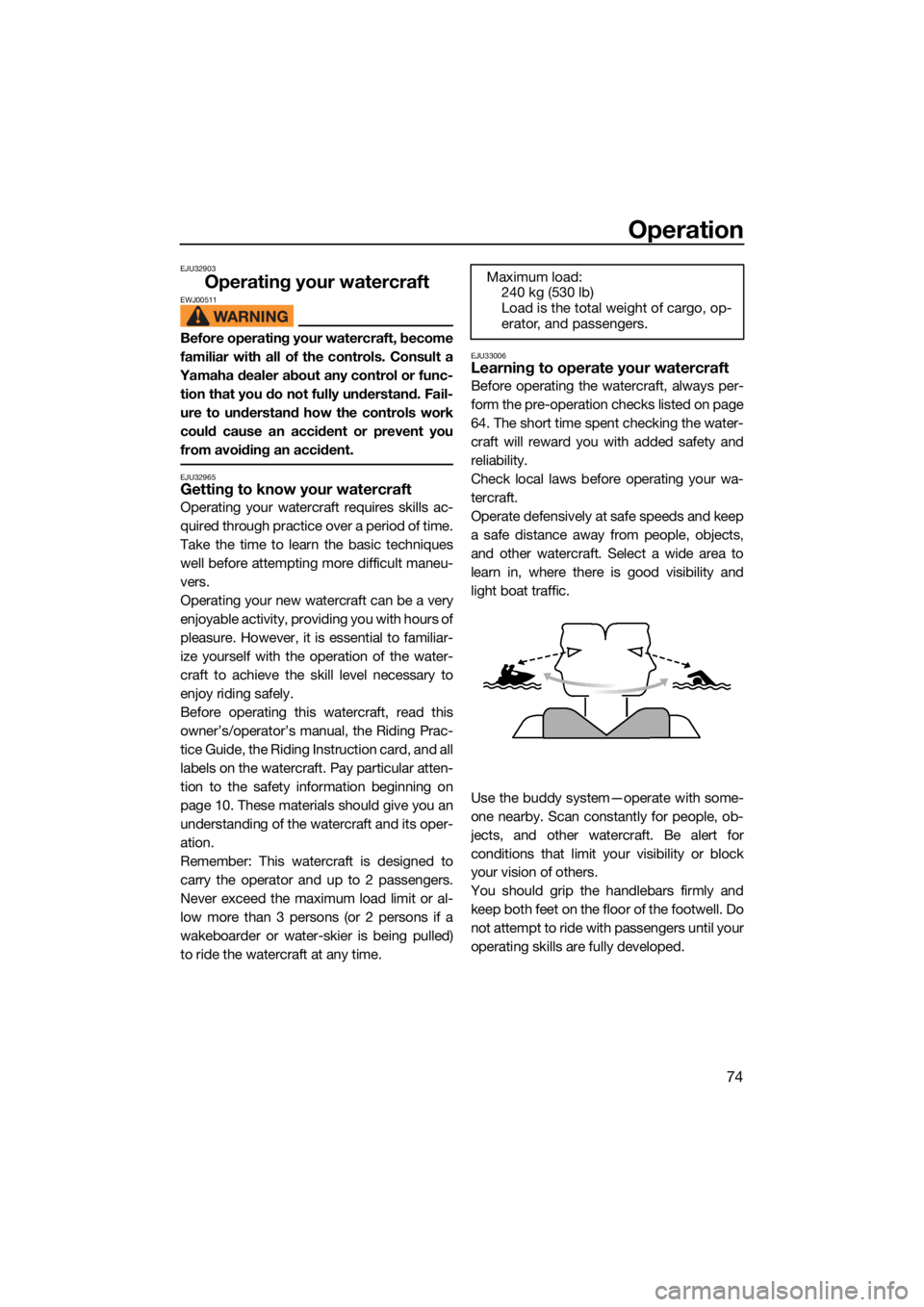
Operation
74
EJU32903
Operating your watercraftEWJ00511
Before operating your watercraft, become
familiar with all of the controls. Consult a
Yamaha dealer about any control or func- tion that you do not fully understand. Fail-
ure to understand how the controls work
could cause an accident or prevent you
from avoiding an accident.
EJU32965Getting to know your watercraft
Operating your watercraft requires skills ac-
quired through practice over a period of time.
Take the time to learn the basic techniques
well before attempting more difficult maneu-
vers.
Operating your new watercraft can be a very
enjoyable activity, providing you with hours of
pleasure. However, it is essential to familiar-
ize yourself with the operation of the water-
craft to achieve the skill level necessary to
enjoy riding safely.
Before operating this watercraft, read this
owner’s/operator’s manual, the Riding Prac-
tice Guide, the Riding Instruction card, and all
labels on the watercraft. Pay particular atten-
tion to the safety information beginning on
page 10. These materials should give you an
understanding of the watercraft and its oper-
ation.
Remember: This watercraft is designed to
carry the operator and up to 2 passengers.
Never exceed the maximum load limit or al-
low more than 3 persons (or 2 persons if a
wakeboarder or water-skier is being pulled)
to ride the watercraft at any time.
EJU33006Learning to operate your watercraft
Before operating the watercraft, always per-
form the pre-operation checks listed on page
64. The short time spent checking the water-
craft will reward you with added safety and
reliability.
Check local laws before operating your wa-
tercraft.
Operate defensively at safe speeds and keep
a safe distance away from people, objects,
and other watercraft. Select a wide area to
learn in, where there is good visibility and
light boat traffic.
Use the buddy system—operate with some-
one nearby. Scan constantly for people, ob-
jects, and other watercraft. Be alert for
conditions that limit your visibility or block
your vision of others.
You should grip the handlebars firmly and
keep both feet on the floor of the footwell. Do
not attempt to ride with passengers until your
operating skills are fully developed. Maximum load:
240 kg (530 lb)
Load is the total weight of cargo, op-
erator, and passengers.
UF3X72E0.book Page 74 Friday, May 29, 2020 10:09 AM
Page 86 of 116
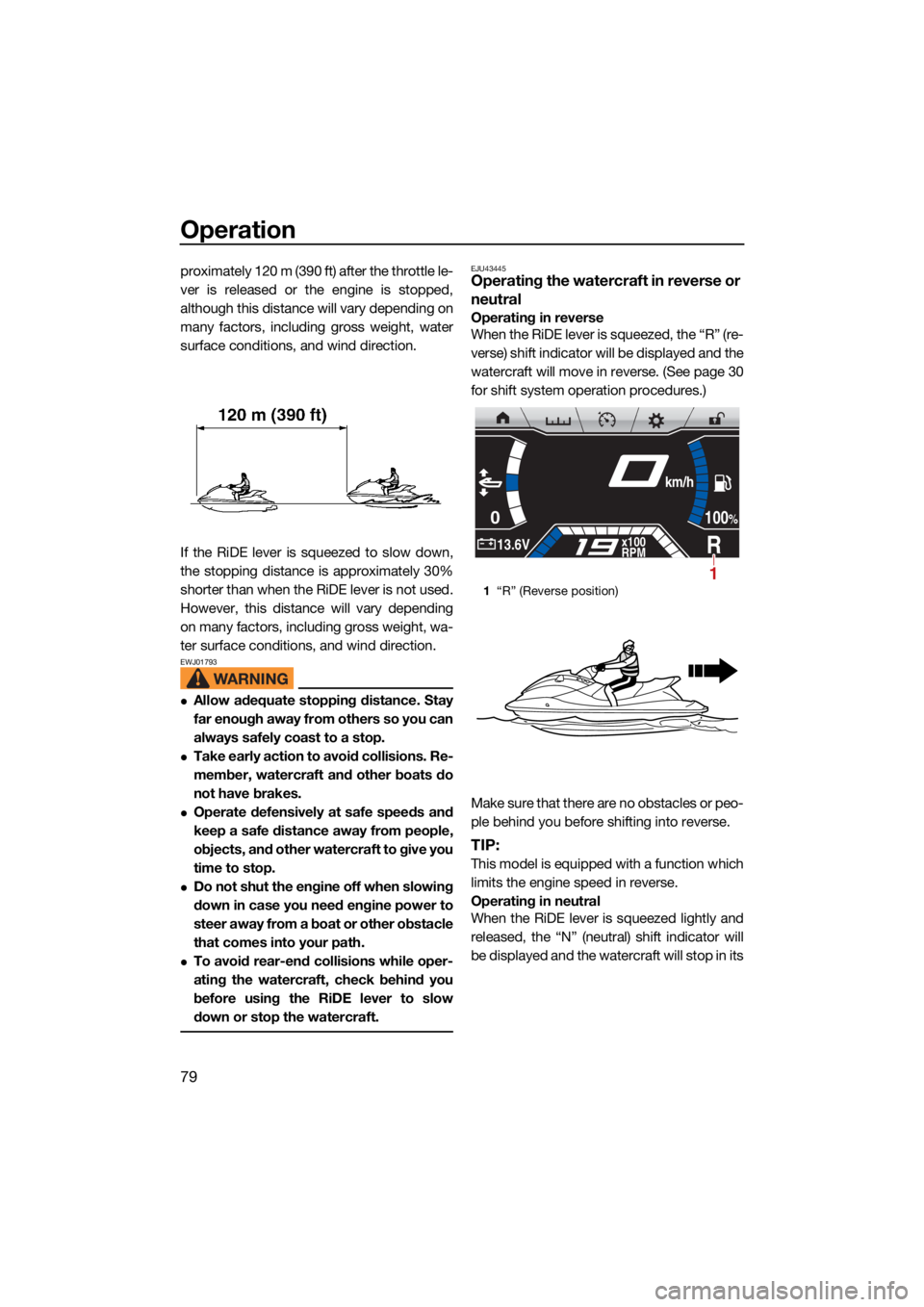
Operation
79
proximately 120 m (390 ft) after the throttle le-
ver is released or the engine is stopped,
although this distance will vary depending on
many factors, including gross weight, water
surface conditions, and wind direction.
If the RiDE lever is squeezed to slow down,
the stopping distance is approximately 30%
shorter than when the RiDE lever is not used.
However, this distance will vary depending
on many factors, including gross weight, wa-
ter surface conditions, and wind direction.
EWJ01793
Allow adequate stopping distance. Stay
far enough away from others so you can
always safely coast to a stop.
Take early action to avoid collisions. Re-
member, watercraft and other boats do
not have brakes.
Operate defensively at safe speeds and
keep a safe distance away from people,
objects, and other watercraft to give you
time to stop.
Do not shut the engine off when slowing
down in case you need engine power to
steer away from a boat or other obstacle
that comes into your path.
To avoid rear-end collisions while oper-
ating the watercraft, check behind you
before using the RiDE lever to slow
down or stop the watercraft.
EJU43445Operating the watercraft in reverse or
neutral
Operating in reverse
When the RiDE lever is squeezed, the “R” (re-
verse) shift indicator will be displayed and the
watercraft will move in reverse. (See page 30
for shift system operation procedures.)
Make sure that there are no obstacles or peo-
ple behind you before shifting into reverse.
TIP:
This model is equipped with a function which
limits the engine speed in reverse.
Operating in neutral
When the RiDE lever is squeezed lightly and
released, the “N” (neutral) shift indicator will
be displayed and the watercraft will stop in its
1“R” (Reverse position)
0
R13.6Vx100
RPM
100%
km/h
1
UF3X72E0.book Page 79 Friday, May 29, 2020 10:09 AM